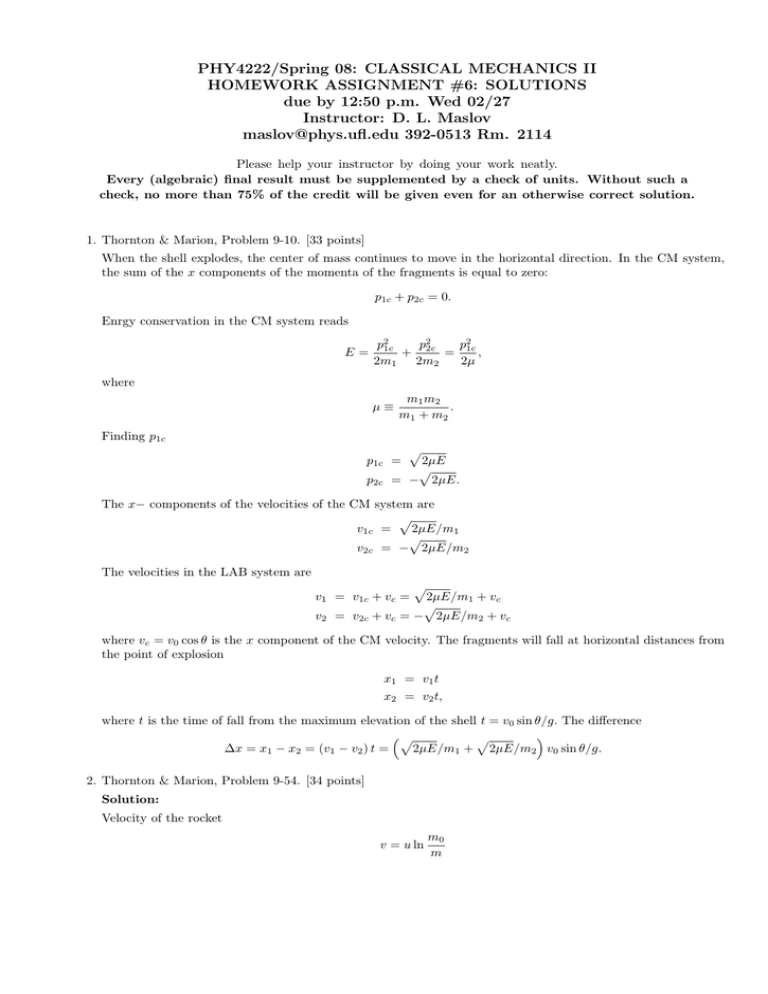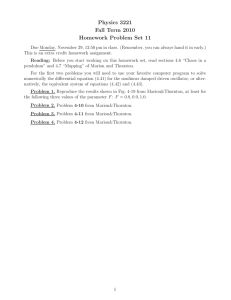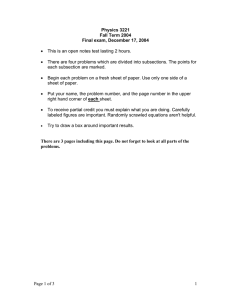PHY4222/Spring 08: CLASSICAL MECHANICS II HOMEWORK ASSIGNMENT #6: SOLUTIONS
advertisement

PHY4222/Spring 08: CLASSICAL MECHANICS II HOMEWORK ASSIGNMENT #6: SOLUTIONS due by 12:50 p.m. Wed 02/27 Instructor: D. L. Maslov maslov@phys.ufl.edu 392-0513 Rm. 2114 Please help your instructor by doing your work neatly. Every (algebraic) final result must be supplemented by a check of units. Without such a check, no more than 75% of the credit will be given even for an otherwise correct solution. 1. Thornton & Marion, Problem 9-10. [33 points] When the shell explodes, the center of mass continues to move in the horizontal direction. In the CM system, the sum of the x components of the momenta of the fragments is equal to zero: p1c + p2c = 0. Enrgy conservation in the CM system reads E= p21c p2 p2 + 2c = 1c , 2m1 2m2 2µ where µ≡ m1 m2 . m1 + m2 Finding p1c p1c = p2c p 2µE p = − 2µE. The x− components of the velocities of the CM system are p v1c = 2µE/m1 p v2c = − 2µE/m2 The velocities in the LAB system are p 2µE/m1 + vc p = v2c + vc = − 2µE/m2 + vc v1 = v1c + vc = v2 where vc = v0 cos θ is the x component of the CM velocity. The fragments will fall at horizontal distances from the point of explosion x1 = v 1 t x2 = v2 t, where t is the time of fall from the maximum elevation of the shell t = v0 sin θ/g. The difference p p ∆x = x1 − x2 = (v1 − v2 ) t = 2µE/m1 + 2µE/m2 v0 sin θ/g. 2. Thornton & Marion, Problem 9-54. [34 points] Solution: Velocity of the rocket v = u ln m0 m 2 Momentum m0 p = mv = mu ln m m0 d d m dp m ln = −u = u m ln dm dm m dm m0 m = −u ln +1 =0→ m0 m/m0 = e−1 ≈ . 367 88... 3. A single-stage rockect is taking off from Earth. a) Find the height of the rocket at burnout. [20 points] Solution Equation of motion in the gravitational field for a constant burnout rate (v (0) = 0) uα dv = −g dt m dv dv dm dv = = −α dt dm dt dm dv g u = − dm αZ m Z m dm m0 g g m 0 dm − u = u ln − (m0 − m) v = α m0 m m α m0 Z m0 Z t Z m(t) dt0 0 v (m ) = α dm0 v (m0 ) y = dt0 v (t0 ) = dm0 0 dm m 0 m0 Z m0 h i m0 g −1 0 0 = α dm u ln 0 − (m0 − m ) m α m Z m0 Z 1 Z 1 m0 0 −1 dm ln 0 = m0 dz ln z = −m0 dz ln z = −m0 z (ln z − 1) |1m/m0 m m m/m0 m/m0 m0 m + m0 − m − 1 = −m ln = m0 + m ln m0 m Z m0 Z m0 −m 1 2 dm0 (m0 − m0 ) = dss = (m0 − m) 2 m 0 uh m0 i g 2 y (m) = m0 − m − m ln − 2 (m0 − m) α m 2α (1) The last equation gives the elevation of the rocket as a function of its mass. If the mass at burnout is mb , then the elevation at burnout is u m0 g 2 yb = y (mb ) = m0 − mb − mb ln − 2 (m0 − mb ) α mb 2α b) How much further in height will the rocket go after burnout? [13 points] Solution According to Eq.(1), the velocity at burnout is vb = u ln m0 g − (m0 − mb ) mb α The additional elevation after burnout is found from the energy conservation mb g∆y = mb vb2 /2 ∆y = vb2 /2g 2 m0 g = u ln − (m0 − mb ) /2g mb α 3 4. Thornton & Marion, Problem 9-54. [34 points] 5. Bonus: Thornton & Marion, Problem 9-56. [35 points] Solution: The rate of condensation is proportional to the cross-sectional area dm = kA = πkr2 dt 4 πρr3 3 dm dr = 4πρr2 dt dt dr k k = → r = r0 + t dt 4ρ 4ρ m = Equation of motion d (mv) dt dv dm m + v dt dt dv πkr2 v + 4 3 dt 3 πρr dv 3 k 1 + v dt 4 ρ r0+ k t = mg = mg = g = g 4ρ Setting τ = 4ρr0 /k , the equation becomes v dv +3 = g. dt t+τ For late time, i.e., for t τ, the equation is simplified to dv v + 3 = g, dt t which can be solved by an obvious substitution v = ct c + 3c = g → c = g/4 For a general case, use a substitution v (t) = v0 (t) C (t) , where v0 is a partial solution of the homogeneous equation (with g = 0) dv0 3 + v0 = 0 → dt t+τ −3 v0 = (t + τ ) . dv dv0 dC = C + v0 . dt dt dt Substituting this back into the equation for v, we obtain v0 dC =g dt 4 which need to be solved with the initial condition C (0) = 0 (I assume that the droplet has zero velocity when it enters the cloud). dC g 3 = = g (t + τ ) dt v0 i gh 4 (t + τ ) − τ 4 C = 4 Finally, −3 v = (t + τ ) " # i g gh τ4 4 4 (t + τ ) − τ = t+τ − 3 . 4 4 (t + τ ) For late times (t τ ), the result reduces to v= g t 4




